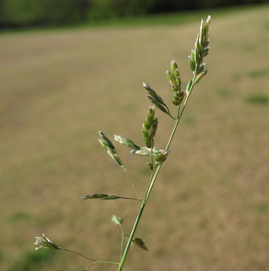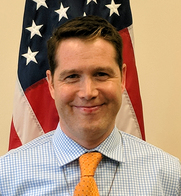|
Having trouble viewing this email? View it as a Web page.

|
|
|
Editor: Kelly Sprute Oct. 24, 2018
Making a Difference

Epidemic in Turf Management: Herbicide Resistance in Annual Bluegrass
Annual bluegrass is one of the most common weeds of turfgrass on golf courses, sports fields, and sod farms, not to mention residential and commercial lawns. Unfortunately this nemesis of pristine landscapes has also developed resistance to many common herbicides. Researchers with the University of Tennessee Institute of Agriculture (UTIA) are participating in a national effort to address what many landscape managers call an epidemic of herbicide resistance in annual bluegrass plaguing managed turf systems. As part of a $3.2 million, 15-state USDA Specialty Crop Research Initiative grant, UTIA turfgrass researcher Jim Brosnan will lead a team of Tennessee weed scientists in sampling annual bluegrass populations across the state. The goal is to quantify the scope of herbicide resistance in annual bluegrass populations across Tennessee. Additionally, Brosnan’s team will develop new diagnostic assays to detect herbicide resistance in annual bluegrass, researching annual bluegrass seed persistence in soil, as well as the effects of turfgrass cultural practices on annual bluegrass infestation. Read the full UTIA news story.
Annual bluegrass is one of the most common weeds of turfgrass on golf courses and it has developed resistance to common herbicides, threatening the profitability of the turfgrass industry. Photo by G. Breeden, courtesy UTIA.
|
|
 Tribal Colleges Celebrate Land-Grant Anniversary
By Scott Elliott
Nearly a quarter of a century ago, members of Congress crafted legislation that allowed us to reach an important milestone in our nation’s effort to achieve equity in research, education, and extension. On Oct. 20, 1994, 29 tribal colleges received land-grant institution status, giving them access to federal government resources, improving the lives of Native students through higher education, and helping propel American Indians toward self-sufficiency. Tribal colleges have a history that predates the legislation that created them; when the 1994s formed, their faculties met and decided it was proper that their college timelines should reach back to the beginnings of their tribal history. This was a hint that something different and special was underway. Read the full USDA story.
Sitting Bull College, Little Big Horn College, and Sinte Gleska College are researching buffalo genetics to improve the health and sustainability of their tribal herds. (USDA photo by Jack Dykinga).
|
 Acting Communications Director
Friday is Dr. Bill Hoffman's last day at the interim director of the Office of Communications. Josh Stull, currently the Congressional and Stakeholder Affairs Officer, will start his 120-day detail as the acting Communications Director Oct. 29. Josh manages NIFA’s Congressional and legislative activities and works to educate members of Congress and staff on NIFA’s mission in agricultural research, education, and extension. Josh came to NIFA from USDA’s Food Safety and Inspection Service, where he served as acting director of Congressional and Public Affairs from November 2015 until April 2016. Then he served as the Congressional and Public Affairs Staff team lead of from May until June 2016.
|
 USDA Announces Receipt of 136 Expressions of Interest in Hosting ERS & NIFA
U.S. Secretary of Agriculture Sonny Perdue today announced that the U.S. Department of Agriculture (USDA) has received 136 expressions of interest from parties in 35 states interested in becoming the new homes of the Economic Research Service (ERS) and the National Institute of Food and Agriculture (NIFA). In August, Perdue announced that most ERS and NIFA personnel would be moving to outside the National Capital Region by the end of 2019 and invited interested parties to submit proposals, with a deadline which had been extended to Oct. 15, 2018. USDA intends to select the new location or locations by January 2019 and will retain a consultant with expertise in relocations. “The interest from across the country has been overwhelming as localities, universities, private entities, and elected officials realize the potential for their communities in become the new home for these two agencies,” Perdue said. Read the full USDA press release.
|
 Draper Named Interim Associate Dean for College of Agriculture
Kansas State University has appointed former NIFA National Program Leader Martin Draper as the interim associate dean research and graduate programs in the College of Agriculture, and interim director, research, K-State Research and Extension. Ernie Minton, interim dean of the college and director of K-State Research and Extension, said Draper will continue as Plant Pathology department head until an interim leader can be named for that post. “We are very fortunate to have someone with Marty’s background and experience serve in this interim role,” Minton said. “Marty will bring fresh ideas and new perspectives as associate dean and director for research. We are looking forward to working with him in the administrative team.” Read the full K-State news story.
|
 Solicitation of Veterinary Shortage Situation Nominations for the Veterinary Medicine Loan Repayment Program
A Federal Register Notice on Oct. 22 published a notice entitled "Solicitation of Veterinary Shortage Situation Nominations for the Veterinary Medicine Loan Repayment Program (VMLRP).”
The National Institute of Food and Agriculture (NIFA) is soliciting nominations of veterinary service shortage situations for the Veterinary Medicine Loan Repayment Program for fiscal year (FY) 2019, as authorized under the National Veterinary Medical Services Act. This notice initiates the nomination period and prescribes the procedures and criteria to be used by eligible nominating officials (state, insular area, the District of Columbia and federal lands) to nominate veterinary shortage situations. Each year all eligible nominating officials may submit nominations, up to the maximum indicated for each entity in this notice. NIFA is conducting this solicitation of veterinary shortage situation nominations under an approved information collection (OMB Control Number 0524-0050). Shortage situation nominations must be submitted before Nov. 21, 2018.
|
NIFA Invests $8 Million to Build Capacity in Extension and Research at the 1994 Tribal Land-Grant Colleges
NIFA recently announced extension and research grants to 1994 Tribal Land-Grant Colleges to develop programs that build scientific capacity and conduct scientific inquiries which address the health, environmental, or agricultural concerns of tribal communities. Funding is made through NIFA’s Tribal College Extension Program, Tribal College Extension-Special Emphasis Program, and the Tribal College Research Program. These grants will touch the lives of reservation youth, farmers, and families to enhance health, promote prosperity, support learning, and assist tribal land-grant institutions become centers of scientific inquiry and learning for remote and rural reservation communities.
NIFA Invests $3 million in Funding for Alaska Native-Serving and Native Hawaiian-Serving Institutions
NIFA recently announced four grants to strengthen the ability of Alaska Native-Serving and Native Hawaiian-Serving Institutions (ANNH) to carry out education, applied research, and related community development programs. ANNH addresses educational needs, as determined by each institution, within a broadly defined arena of food and agricultural sciences-related disciplines. Priority will be given to those projects that enhance educational equity for underrepresented students; strengthen institutional educational capacities; prepare students for careers related to the food, agricultural, and natural resource systems of the United States; and maximize the development and use of resources to improve food and agricultural science teaching programs.
NIFA Invests $1.9 Million to Support Agriculture and Food Science Education in Insular Areas
NIFA recently announced 14 grants to support projects that strengthen food and agricultural science education in insular areas of the United States. Funding is made through NIFA’s Resident Instruction Grants Program for Institutions of Higher Education in Insular Areas, Agriculture and Food Sciences Facilities and Equipment Program for Insular Areas, and the Distance Education Grants. These programs work to strengthen institutional education capacities in curriculum, improve post-secondary agricultural science education, and upgrade or construct science facilities and equipment necessary to conduct tropical and subtropical agricultural research.
NIFA Invests $1.24 Million in Research to Improve Domestic Aquaculture Production
NIFA recently awarded four Aquaculture Research Program grants for research to support the development of new science-based information and technology for environmentally and economically sustainable aquaculture industry in the United States. The Aquaculture Research Program is authorized by the Competitive Special and Facilities Research Grants Act to develop practical solutions that will facilitate growth of the U.S. aquaculture industry, reduce the U.S. trade deficit in seafood products, and enhance the capacity of the U.S aquaculture industry to contribute to food security and economic growth.
|
|
|
NIFA’s mission is to invest in and advance agricultural
research, education, and extension that solve societal challenges. NIFA’s
investments in transformative science directly support the long-term prosperity
and global preeminence of U.S. agriculture. Keep informed about NIFA, USDA,
our land-grant and non-land-grant universities, and stakeholders with the NIFA
Update. Read past issues online,
sign up for email
updates or follow us on Twitter @USDA_NIFA, #NIFAImpacts.
If you wish to submit a news item or information, send an
email to NIFAUpdate.
USDA is an equal opportunity lender, provider, and
employer.
|
|
|
|